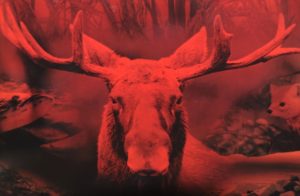Chiefs forewarn on environment issues at Lands and Resources Forum

By Kelly Anne Smith
NORTH BAY—It is fitting that the 2016 Lands and Resources Forum: We Are All Connected, featured an image with a bull moose. There was concern for the great beast during the three-day Lands and Resources Forum held at the Best Western. The event attracted Ontario’s representatives as well as Anishinaabe government representatives, scientists, policy analysts, citizens and artists.
Stern voices were heard from the opening panel session on the state of natural resources in Ontario. Val Monague, former Chief for Beausoleil First Nation, explained how a crop of wild rice was cut down by cottagers. Regional Grand Chief Paul Eshkakogan warned the moose are in danger from the forestry practice of spraying to ‘clean’ undergrowth in crown controlled forests.
The Union of Ontario Indians Lands and Resources department coordinated the conference to establish a framework for round tables in each region of the Anishnaabe Nation. Dokis First Nation citizen Rhonda Gagnon, a Lands and Resources policy analyst with the Union of Ontario Indians, talked of the regions needing to be supported more in their endeavors.
“We have individual communities that have challenges with projects,” noted Gagnon. “As a region, they can support each other on a Treaty basis and understand what other regions are going through. There are different resources in a southern region than in a northern region and there are challenges with that.”
The Anishinabek Nation is divided into four regions.
The Director of Lands and Resources department is Jason Laronde, a Nipissing First Nation citizen. Laronde wants to strike a balance when managing the stress and strain on the natural resources.
“The forum’s number one goal is to build positive working relationships with each First Nation, our citizens, the government, industry and academia,” stated Laronde.
Laronde talked of opening communication between the grass roots level and the regional level.
“We are a coming together of our community members, our technicians, and our leaders—those involved in forestry, mining and climate change,” noted Laronde. “This creates a springboard of support for the long-term.”
Nipissing First Nation Chief Scott McLeod explained that Lake Nipissing’s walleye is at risk. Chief McLeod talked of community law being hampered by the Crown imposed Indian Act.
“We are not managing the rights of moose and deer—we are managing people,” stated McLeod.
Grand Council Chief Patrick Madahbee also called for reason to give the moose, deer, and Lake Nipissing walleye a chance.
“It’s unfortunate other groups didn’t abide on the moratorium to let those fish get a chance,” noted Grand Chief. “If they shut down the pickerel in a particular bay, all that revenue is lost. If they keep doing this, there will be nothing left to fish. Only about 18% of those doing the fishing are Anishnaabe people.”
The Grand Council Chief called for a myth to be broken about First Nations being to blame for dwindling resources.
“At an early age we learn responsibility,” noted Grand Chief. “The animal diet is such that they are only good to eat at certain times of the year. The fat content isn’t as good or the particular vegetation they are eating turns the flesh a different taste.”
“I come from a community of 850 people that have the right to go out and fish,” continued Grand Chief. “We have about 450 on the reserve with about 15 active hunters. Out of those 15 are maybe nine that I would call serious hunters. They will bring home maybe four moose a season that is shared around the community.”
Grand Chief Mahdabee is pleased with the many dialogues taking place during the forum.
“I think with the different ministries coming here, all parties will get a chance to talk and listen, and listen and talk to each other,” noted Grand Chief. “What I particularly like is that you have a lot of the front line people here that deal directly with land issues in the communities. They are the ones with the day to day experience.”
Regional Grand Chief Paul Eshkakogan is calling for a one-year moratorium on aerial spraying of forests on the north shore of Lake Huron.
“They impact the moose twice,” stated Regional Grand Chief. “When they take out the trees, the moose leave that area. Then the moose come back to feed on the shrubs. Then they spray it again and displace the moose again.”
Chief Eshkakogan wants to work in consultation with the sustainable forest licensees to find out where the areas are to be sprayed.
“We have to get some people on the ground to go into these areas,” stated Regional Grand Chief. “We can tell if there is going to be a good blueberry crop. We can tell if there are moose feeding there right now.”


